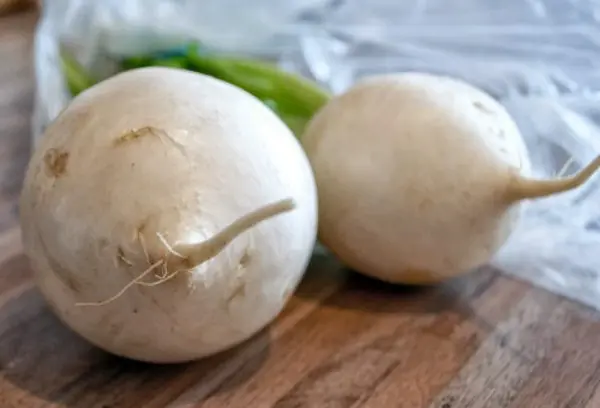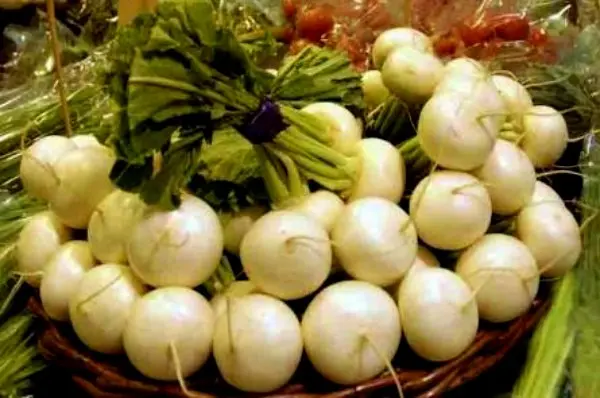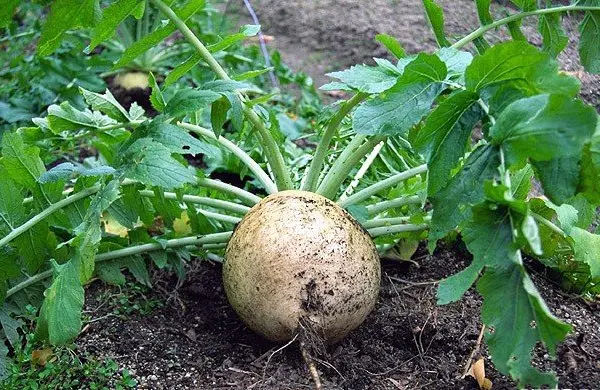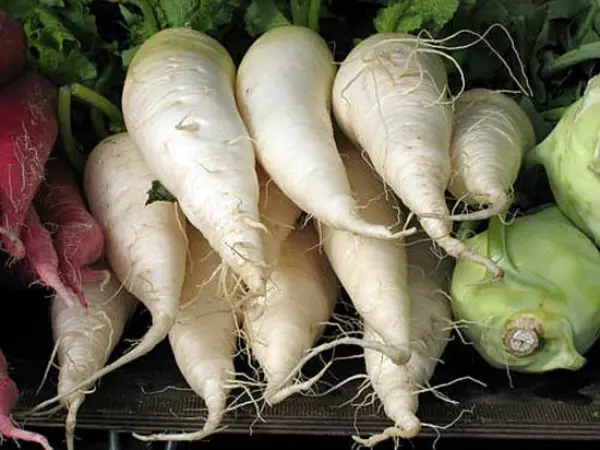Contents
Radish is a fairly common garden crop. Having migrated from Asian countries, it quickly gained popularity in Europe, and now its cultivated species are grown everywhere. Of the variety of varieties, white radish is more valued. It contains a huge amount of useful substances, vitamins and essential oils, which give the vegetable not only high nutritional, but also medicinal properties.
Variety description
White radish is an annual or two-year vegetable crop of the Cabbage (cruciferous) family. The one-year development cycle is typical for summer and early varieties. In winter varieties, the full vegetation period takes two years – in the first year the plant forms a root crop, and in the second it blooms and produces seeds. A white root crop can have a wide variety of shapes: round (Mayskaya, Winter White, Odessa), elongated or conical (Elephant’s Fang, Grayvoronskaya, Loba).

The pulp of white radish is juicy and crispy, slightly spicy in taste. Unlike black, it has a softer and more delicate taste. Recently, Japanese radish, whose name is daikon, has been very popular. Its root is long and very juicy, with a sweet and spicy taste, as unlike our traditional varieties, it does not contain mustard oils. Daikon or the so-called “Japanese radish” (in the version it can be called “sweet radish”) also has many varieties and varieties that differ in shape, size, and even the color of the pulp. For example, the Flamingo hybrid has bright pink flesh, despite the fact that its surface is snow-white.
White radish is completely unpretentious. It easily tolerates night frosts and even short frosts, which makes it possible to grow a crop not only in temperate climates, but also in northern regions. According to the ripening period, it is divided into summer varieties (ripen in 50-70 days), which, in turn, are divided into early, mid-ripening and late, as well as winter – ripening in late autumn, and intended for winter use.

Summer varieties are in great demand, as the pulp of these root crops is juicier and more tender. Root crops of winter varieties are distinguished by denser and sharper pulp, but they also last longer. Almost all types of white radish, with the exception of a few winter varieties, are annual plants – they form roots and seeds in one year, so you should not hesitate to harvest, because when overripe, vegetables can release an arrow.
Choosing a place and soil
Despite the fact that the culture is unpretentious, it is necessary to create elementary conditions for its cultivation. When choosing a place for planting, it should be borne in mind that radish is a plant with a short daylight hours. Root crops need cool temperatures and 10-12 hours of daylight to thrive. And if it is not difficult to create these conditions when planting summer varieties, then problems can arise with the cultivation of winter varieties, which are usually planted in the middle of summer.

Under the winter crop, it is better to choose areas that are illuminated by the sun in the first half of the day, and in the afternoon they are in the shade – otherwise the root crops will grow small, and even before the onset of autumn they will release an arrow. The bed for planting should be flat, without depressions and lowlands, as the culture does not tolerate stagnant water. At the same time, for the successful growth of root crops, it is necessary to maintain a constant but moderate humidity, this is especially important at the beginning of the growing season.
As for the composition of the soil, the white radish prefers loose and fertile loamy, as well as sandy loamy soil with neutral or slightly alkaline acidity. The main thing is that the soil is not acidic, otherwise the root crops will develop poorly and rot. Before planting seeds, the soil is dug up to a depth of 20–25 cm, humus or compost (0,5 buckets / 1 m²), ash is added for digging. In acidic soil it is necessary to add slaked lime.
For planting summer varieties, the bed is prepared in the fall, for winter – in the spring.

For a white radish, it is important who was its predecessor, as well as who is a neighbor. The culture grows well after corn, legumes, any pumpkin crops (squash, zucchini). The culture feels great in the neighborhood of cucumbers, tomatoes, peas. To save space, some gardeners plant radish between cucumbers or squash, and it grows quite successfully there. Undesirable predecessors for culture are: horseradish, carrots, beets, any kind of radish and cabbage.
Dates and landing scheme
The timing of planting radish depends on the variety and type. Summer plants are planted in open ground quite early, as soon as the soil warms up to + 3–5 ° C. Early varieties are more cold-resistant, so they can be planted in the second half of April, mid-ripening and late – in early May. It is important to sow the seeds as early as possible so that the root crops have time to ripen before the onset of the summer heat, and do not throw out the arrows ahead of time.

For planting winter varieties, the recommended time period is from the last decade of June to mid-July. For the southern regions, the deadline is considered to be the beginning of August, but one should not delay planting seeds longer, as the root crops will not have time to ripen, and the harvest may not wait.
Radish is planted with seeds directly into the ground. It is important to know that good quality healthy seeds are brown, not grey, black or whatever. A change in the color of the seed indicates that it has deteriorated and is unsuitable for sowing. Seeds are planted in pre-prepared furrows of 3-4 pieces at a distance of about 15 cm. The distance between the nests depends on the variety. Round radish (Mayskaya, Odessa), as well as winter varieties, are recommended to be planted at a distance of 20 cm. Long root crops (Dragon, Sultan, Munich) can be planted more densely – at a distance of 10–15 cm.

Advantages and disadvantages
The main advantage of white radish is, of course, its extremely useful composition and medicinal properties. Root vegetables are widely used in folk medicine to treat coughs, increase appetite, strengthen immunity and solve a number of health problems. Refreshing, slightly spicy taste makes the vegetable indispensable in the diet and composition of many dishes. Radish is a versatile root crop, it can be eaten fresh, in the form of salads, cook a variety of side dishes and even hot dishes.
The radish itself almost never gets sick, which is also its positive quality. Perhaps this is due to the high content of esters and biologically active substances in the composition, which not only endow the roots with healing properties, but also protect them from damage by fungal spores and other bacteria. The unpretentiousness of the culture and high productivity can also be attributed to the advantages – the productivity of winter varieties of white radish is 4–6 kg per meter of area.
Of the shortcomings, it can be noted, perhaps, that the susceptibility of summer varieties to the attack of harmful insects. If root crops are of little interest to parasites, then young greens are a real delicacy for cruciferous fleas, larvae and caterpillars. Therefore, it is more profitable to grow winter varieties of radish, since at the end of summer harmful insects are no longer so active.
Video “Agrotechnology for growing Daikon”
From this video you will learn about the properties of Daikon and the technology of its cultivation.









